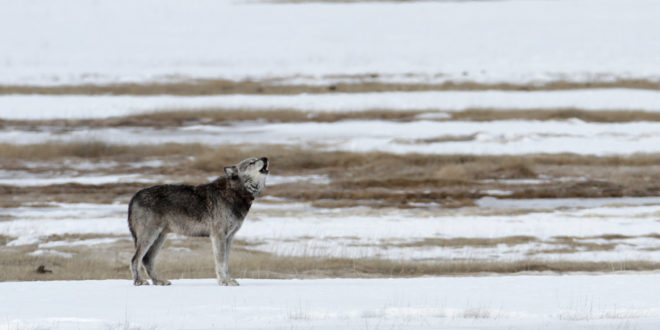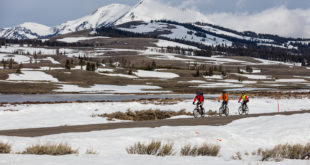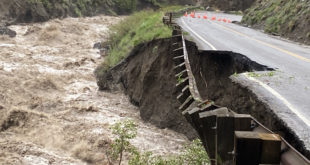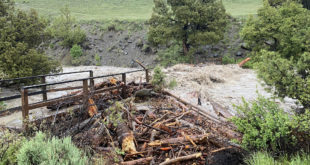Looking to learn more about Yellowstone wolves? The Yellowstone Wolf Genealogy Family Tree project is here to help.
According to the Billings Gazette, the project, offered through Ancestry.com, collates life histories of individual Yellowstone wolves since their reintroduction in 1995-96. The project, founded by biologist Jim Halfpenny, is a generalized view of wolf heritage and lineage in the park.
Wolfwatching is, of course, a popular activity in Yellowstone National Park. Per the Gazette, an estimated hundreds of thousands flock to the park each year to see wolves. From the Gazette:
The popularity of his genealogy charts became apparent to Halfpenny, a Gardiner-based biologist, after he started recording the lineage of Yellowstone’s wolves when they were first reintroduced to the park in 1995 and 1996.
“Through the years I’ve produced these laminated charts, selling about 4,000 a year,” he said. Now folks can order them online.
He updates the data yearly, using information gathered from multiple sources, including the Yellowstone Wolf Project. That’s no small task considering there can be more than 100 wolves scattered across the park’s 2.2 million acres each year. At their population peak there were more than 170 wolves inside Yellowstone.
“We started out trying to do it by volunteers, and it was too overwhelming,” Halfpenny said.
So using a Kickstarter project to fund development — 273 people contributed more than $26,000 — Halfpenny was able to “put online the lives, pedigrees and genealogy of the Yellowstone wolves for access of all fans,” according to the website. The digital information is “enormous in scope and the first of its kind in the world.”
Those interested can go to www.wolfgenes.info to learn more about the project. Perusing Ancestry.com requires the payment of a membership fee. The information is also now available on a cellphone app allowing wolf devotees to carry the data with them into the field.
[…]
“I’m fascinated with it, following the family lines,” Halfpenny said.
The intrigues include female wolves mating with their fathers, grandfathers and even brothers.
“There are all sorts of complexities to this,” he said.
For each wolf recorded on the website there is a life story to be read, as well as facts and a photo gallery if shots are available. Adapting such complex family relations to a website was a challenge since the Ancestry.com formula was set up for humans who give birth to about one offspring a year, not 4.4 a year, which is the average litter size for Yellowstone wolves.
“So we had to work around problems like that,” Halfpenny said.
He compared the information to tracking the Smith family tree for all of North America.
Speaking of Smiths, according to the Gazette, Yellowstone wolf biologist Doug Smith cautioned that the site is better suited for wolfwatchers than professional biologists; about 40 percent of Yellowstone’s wolf population is captured each year for DNA samples, a surer way of tracking lineage and heritage across the park. Halfpenny admits that even the most devout wolfwatcher can make mistakes, such as mixing up the gender of observed wolves.
Nonetheless, Halfpenny hopes his project will help people visualize the interconnections apparent in Yellowstone’s wolf population. He also hopes the Yellowstone Wolf Genealogy Family Tree helps people understand individual wolves more than they would otherwise.
It’s a pressing concern, especially now. Just a few weeks ago, one of Yellowstone’s most noteworthy wolves, the alpha female of the vaunted Canyon Pack, was found mortally wounded just within Yellowstone’s northern boundary. Employees on the scene decided to euthanize her on-site. A necropsy later determined she had been shot. There is a $10,000 reward (half from the National Park Service, half from a private group) out for information on her killer—should it lead to their arrest and conviction.
According to the Gazette, the Canyon Pack alpha female, which lived to be about 12-and-a-half—ancient in wolf years—lived a storied life:
Even before her tragic death, the 12-year-old wolf had led a life worthy of an epic poem. Two years after being born into the Hayden pack her parents were killed by the rival Mollie’s pack. This is known as intraspecific mortality, when wolves kill wolves, and accounts for about 42 percent of all wolf deaths in Yellowstone — more than any other single factor.
The white female is believed to have later bred with an unknown black wolf from Mollie’s pack — the same wolves that had killed her parents. This coupling produced a black pup — 638M. The pup became a star in Bob Landis’ 2010 film “The Rise of Black Wolf,” but died when it was only a year old. Landis’ film chronicled the story of a different black wolf, 302M.
For some reason the white alpha female’s first pairing didn’t last, and she found a new mate, who also was a member of the Mollie’s pack — 712M. Together with another Mollie’s male in 2008 they formed the Canyon pack in the center of the park.
It’s likely Yellowstone wolves will face additional pressures going ahead, as Wyoming is poised to resume management of wolves within the state. With hunting seasons all but assured, some biologists, including Smith, worry that hunting outside the park will affect wolves within it—make them more reticent around people, more likely to stay out of sight and therefore further out of reach from researchers. Smith even cautioned it could fundamentally alter his and others’ research into Yellowstone’s wolf population.
In light of Wyoming’s move to accede management duties once more, Protect the Wolves, a Native American advocacy group has called for a ban on hunting around Yellowstone National Park and is prepared to sue over it.
 Yellowstone Insider Your Complete Guide to America's First National Park
Yellowstone Insider Your Complete Guide to America's First National Park





